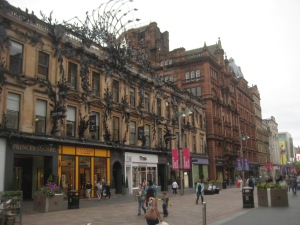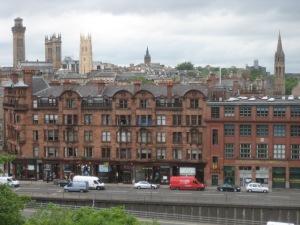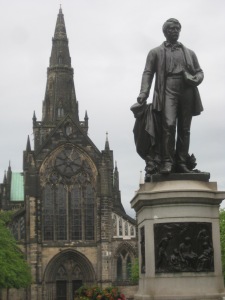Since high school, we both have wanted to travel to London, and this last weekend, we finally got the chance. Thanks to some good friends who are spending their summer in Central London, we were able to fly down from Edinburgh, spend two nights, see the major sites, and head back. It was a great opportunity to explore this iconic metropolitan city and experience some of hallmarks of English culture and British history.
On Friday, we set a personal record for number of steps walked in 2015... by a lot. We walked down to and crossed the River Thames (pronounced "tems") and stopped for lemonade on the South Bank to enjoy the view of the British Parliament and Big Ben from afar. Then we crossed into the Westminster neighborhood, passed by Downing Street (official residence of UK Prime Minister David Cameron), and walked right up to Big Ben, Parliament, and Westminster Abbey. Even though we had seen it in a million pictures, Big Ben (technically, the clock tower of Westminster Palace that contains the bell known as Big Ben) was impressive in its size and ornateness, We then headed north to Buckingham Palace and Piccadilly Circus--both swarming with people--and then got dinner in Soho. We ended the evening with a mission to locate Soho's "Broad Street Pump", which symbolizes the birthplace of epidemology (Joye's public health specialty) after Dr. John Snow identified it as the likely source for Soho's cholera outbreak in 1854. Unfortunately, the pump has recently been removed, and the bartender at the nearby John Snow pub did not even know what we were talking about, but we had fun wandering through this neighborhood nonetheless.
Over the two days, we toured inside of London's major sites. We started with Westminster Abbey--England's most important church--which has been the traditional site for marriages, coronations, and burial of British royalty, including William and Kate's wedding most recently. Westminster Abbey is also a sort of Cemetery of Fame and includes the resting place of many monarchs, prime ministers, and other reputables such as Isaac Newton, William Wilberforce, Charles Darwin, Geoffrey Chaucer, and Charles Dickens, to name a select few. We also toured the British Museum quite extensively and enjoyed their amazing collections of Egyptian and Greek artifacts as well as learning more about the history of people on the British Isles.
Getting outside, we particularly enjoyed getting ice cream while touring the Kensington Palace gardens and strolling through Hyde Park. We also made an effort to quickly see touristy sites like the Beatles's Abbey Road and Harry Potter's Platform 9 and 3/4, but these were naturally overwhelmed with crowds and cameras. But away from those sites, we learned that London is a vibrant and diverse metropolitan city. Outside of the attractions, the character of London seems to be much more of a melting pot--like New York City, for example--than of a distinctly British town. Perhaps this is why some Brits consider London to be an almost sub-country removed from the workaday lifestyle of the rest. While Joye and I concluded that we prefer the character and proximity of a smaller city like Edinburgh, visiting London was an amazing experience, especially with hospitable and generous friends.
-James (& Joye)
Wednesday, July 1, 2015
Pharmacy Rotation - Week 2
The highlight of this week is that I finally got access to my data! This means that I begin my research project. As I mentioned in a previous post, I am looking at prescribing of the “4-C” antibiotics : Co-amoxiclav (i.e. augmentin), Cephalosporins, Ciprofloxacin (Quinolones), and Clindamycin. These antibiotics can be associated with higher levels of hospital associated infections, so it’s important to regulate their use and try to promote minimizing their use. I had fun getting trained on a new software system and starting to look into my research question.
I also had the opportunity to travel to Glasgow again and observe the New Drugs Committee Meeting (Similar but not exactly like the FDA of Scotland). This was really interesting because as part of the Scottish Medicines Consortium, the NDC reviews all the current literature pertaining to a drug’s safety and efficacy and does a cost-effectiveness analysis on the medication. The group of experts in pharmacy, pharmacoepidemiology, and health economics then meet to discuss whether the drug should be approved for use within Scotland. This approach is so different from the system in the US, where we will let whoever can pay for a medication receive it. In Scotland, on the other hand, drug companies have to prove that the benefit of the drug is worth the extra money that it costs. This is a pretty simplified version of what they do, so if you are interested to learn more, you can read about it here.
Also, while I think I still prefer Edinburgh, it was fun to explore Scotland’s largest city (Glasgow) and see some of its unique architecture.
Subscribe to:
Posts (Atom)






